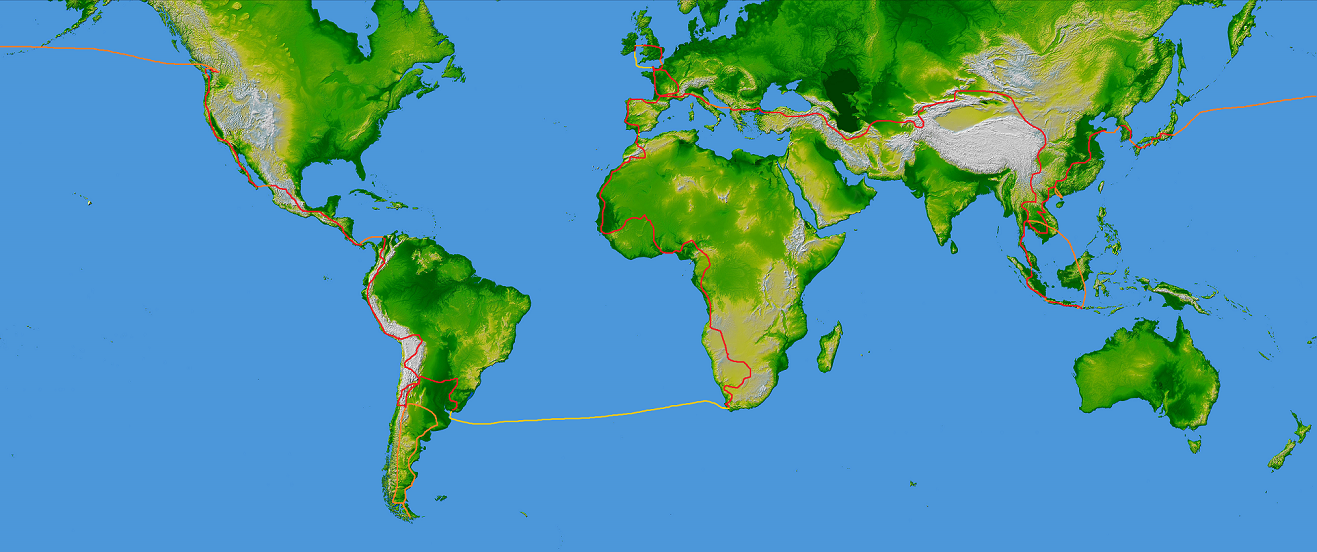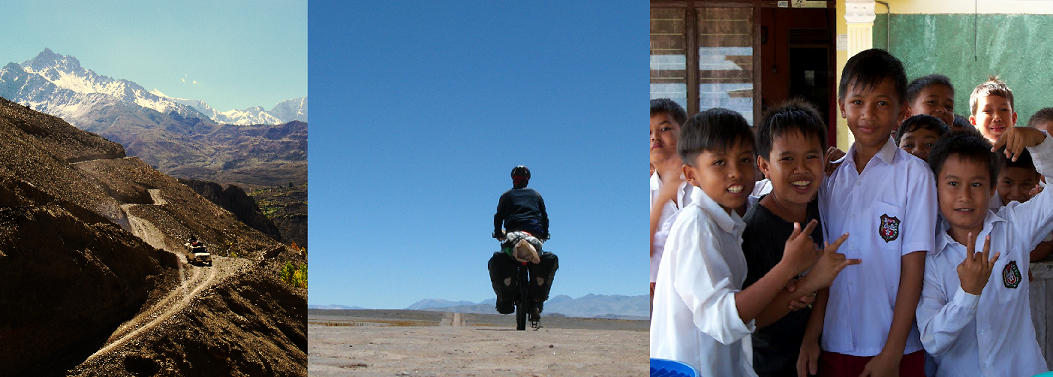Thirty kilometres before the Cambodian border town of Koh Kong, in the verdant tropical rainforest of the southern Cardamon mountains, the first rain we've seen since leaving Vietnam in December could be heard before we felt it. The towering cumulonimbus had been building all morning and by mid-afternoon the black sky closed over. As we pedalled towards the only offer of shelter - an empty bamboo building by the roadside - the downpour roared through the canopy, crushing the leaves on which it fell. Unusually for Cambodia the highway we were travelling on was not dotted with ribbon settlement patterns where poor households hack away at the surrounding forest to turn it into agricultural land. This important biome has been preserved as both a legacy of the war years and the associated threat of unexploded ordnance, as well as by recent co-ordinated action by environmental groups and local groups to curtail the rampant illegal logging that was so widespread in the 1990s.
Back in Thailand. Back to fridges. Fresh milk and yoghurt. Anonymity. Our first night is on a beach at La Ratchakarun about 40 km from the border post. As the sun sets over the Gulf of Thailand we swim in the steamy sea water. I've had cooler baths. We pitch up under a shelter and cook our vegetable curry whilst watching the rain thunder down. Thirty years ago the beach was a Red Cross refugee camp, where those who had managed to escape the horrors of the Khmer Rouge in Cambodia came to sleep under a plastic tarpaulin. Photos of skeletal youngsters in their mother's arms adorn the walls in the administration building.
Past Trat the highway widens and the traffic thickens. A night in the gem town of Chanthaburi and then Klaeng. Riding out along Route 344 the following morning, past the roadside fruit stalls selling jackfruit and pineapple, we're overtaken by Eric and Amaya - another pedalling couple. They've been cycling for the past six years and I recognised Amaya straightaway from their website. We had been in contact via email a few years ago when I was setting out across west Africa and they wanted some information about Lesotho. And five years later and here we meet. Before the end of the day we meet again as they are having tyre problems and we lend them our spare so they can ride to Bangkok, where we meet again for dinner. Later Amaya interviews us for their Touring Talk series. Interestingly I see that they interviewed a fellow cyclist Tyson in Alaska, whom we cycled with for a couple of days in Oaxaca, Mexico. A small world? Somedays.
Arriving in Chonburi, an unloaded Thai cyclist pulls up. We both have Rohloff gear systems. Blood brothers. After showing us to a cheap guesthouse in town, he fetches his friend Mr.Ton, the man responsible for the Rohloff epidemic in Chonburi, where he has built up eight bikes with the internal gear hub. That represents over half of the total number of Rohloff hubs in Thailand Ton muses later. His job at a nearby Mitsubishi electrics plant doesn't leave much time for cycling trips. And his partner doesn't like cycling he laments. Others will have to do it for him. Ton gives us the name of a touring-specific bike shop in Bangkok that imports Thorns and Surlys and calls the owner to tell him we'll be paying a visit.
Eighty kilometres from Chonburi to Bangkok. After a frantic ride along Highway 34, we turn off onto the relatively subdued Highway 3 and skirt along the coast, past the salt workers and into the metropolis. Our first couple of nights in the city are spent with a friend of Ellie's brother. Tom and Mam bring us into their family and make us feel wonderfully welcome. Zoe and Naomi want to come cycling too.
We had anticipated a hit-and-run visit to Bangkok but it was the place to get things done and our weekend has turned into a week. Most of the things to be done involved pushing tubes in and out or up and down. Ellie had a gastro endoscopy to determine whether her innards were faring well. A combination of factors had been causing problems, including perhaps a negative reaction to the anti-malaria pills (doxycycline) that we've been taking. She's on another industrial strength regime of antibiotics and antacids but hopefully it will be all sorted now. The bikes also needed some loving and we eventually tracked down Ma (means 'dog' in Thai) and Kop ('frog') at the Bok Bok bike shop (662 Krung Kasem Road, near Wat Sommanat. Tel: +66 (0) 87 6822236) which has filled all of our social as well as cycling needs over the past few days.
After training as a metallurgical engineer and then being released from industrial bondage a couple of years ago, Ma followed his passion and set up a touring-specific bike shop and began importing Thorns, Surlys and other beasts of burden. He carefully examined our bikes between an almost constant stream of phone calls and the occasional walk-in. He talked us through things carefully, showed us where the wear and tear was and made recommendations for what needed changing or replacing. It seemed like a good time to attend to some overdue jobs such as my stuck seat post that last moved two years ago. Ellie is getting a new rear wheel built and her cranks had to be replaced when the crank bolt was found to have seized on. Hubs and headsets serviced, cables replaced and for the six days a different strategy has been adopted each day in an effort to release the offending seat post from Rocinante. So far rubber mallets, industrial degreaser, drilling and small amounts of acid have all failed miserably to set Rocinante free. Today its time for the saw. Ma's shop is as much a social exchange as a commercial enterprise and there are always a couple of friends lingering around, sharing food or a beer in the evening and mostly coming up with new ideas for removing the seat post or new tunes for the ukelele. Come Saturday night, it's party time and new frames and old tyres are set aside and a couple of fold-out tables emerge as people gather with their offerings for the evening feast.
Bangkok is a crossroads as we run out of land and passable borders. Whilst neighbouring Myanmar (Burma) has slowly begun to open its doors to the outside world recently, it's still not possible to continue past their border towns by bicycle and coupled with the travel restrictions in Tibet, the Indian subcontinent is impenetrable overland from this side of Asia, except via the Karakoram highway through Pakistan. This was our original intended escape route from south Asia, over the Himilayas and into western China and central Asia. The traditional overlanding route via southern Pakistan and Iran is now made difficult by visa and travel restrictions (the former apparently not being issued outside your home country at the moment and the latter involving long enforced bus journeys through Balochistan and eastern Iran - hardly an inviting prospect for a glorious finale). So that leaves the most promising option being the increasingly popular route from south east Asia, through western China to central Asia along the fabled Silk Road routes. While ancient traders may have had other challenges to surmount, the legacy of the Russian Soviet state lives on in the consular offices responsible for issuing visas to this area. So for now, our plan is to follow this route home - taking about 12 months from the end of this year to reach the Celtic isles. In the meantime we plan to continue southwards to Malaysia and Indonesia (Sumatra) before returning to Bangkok in mid-July where Ma has kindly offered to store our bikes and gear. After a visit back home to get new passports and wish Ellie's grandfather a very happy 100th birthday, we plan to return bikeless to the Himilayas in Nepal and northern India to walk in the clear autumn skies before returning to Bangkok and resuming the ride home.
Bangkok, Thailand
Pedalled: 58,944 km
























































